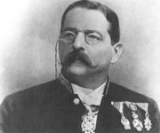
Gottfried Schenker
Encyclopedia

Gottfried Schenker in its full name the Swiss Confederation , is a federal republic consisting of 26 cantons, with Bern as the seat of the federal authorities. The country is situated in Western Europe,Or Central Europe depending on the definition....
- 26 November 1901 in Vienna
Vienna
Vienna is the capital and largest city of the Republic of Austria and one of the nine states of Austria. Vienna is Austria's primary city, with a population of about 1.723 million , and is by far the largest city in Austria, as well as its cultural, economic, and political centre...
) was the founder of Schenker AG
Schenker AG
Schenker AG is a German logistics company and a subsidiary of Deutsche Bahn, the German railway company. Within DB Logistics, the logistics branch of Deutsche Bahn, Schenker is responsible for land, sea, and air transport and contract logistics...
.
At the age of 30 Schenker together with two partners founded the freight forwarding company Schenker & Co on the 1st of July 1872 in
Vienna. The managerial ingenuity of the Swiss-born entrepreneur was the introduction of groupage consignments by train. The idea to consolidate
small shipments into larger units led to a completely new, reasonably priced and fast transport system by rail, road, sea and inland waterways.
The network of branches was expanding rapidly. At the end of the 19th century, Schenker already was the only enterprise offering tariffs calculated through from London to Istanbul. His success-winning approach - "House to house transport with one single forwarder" - soon made him market leader, as he was able to meet the requirements of his customers better and faster than all the competitors. The company has maintained this approach until today. A present-day historian wrote about Gottfried Schenker, who died in 1901, "He was one of the great economic pioneers of the 19th century and became renowned far outside the borders of the Austro-Hungarian empire".
At the turn of the century, Vienna was a metropolis in a country at the heart of Europe, where 10 languages were being used actively. Starting from Vienna, the company opened up markets within and without the Austro-Hungarian monarchy. In rapid succession, Gottfried Schenker founded branches in Budapest, Trieste, Prague, Belgrade, Sofia, Salonika and Constantinople. At that time, the distribution within the cities and individual regions was still carried out by horsedrawn coaches. Impressive warehouses, like the one in Vienna, acted as trade hubs. Consignments for longer distances were transported by rail. However, groupage transports across the entire continent or the transport of bulk cargo also required transport by sea. Anticipating further developments, Gottfried Schenker acquired interests in shipping lines.
Starting from Trieste, he organized transports across the Mediterranean Sea, to Belgium, the Netherlands, Germany and Great Britain, as well as to the United States of America. The company's ships with his own name, "Gottfried Schenker" and that of his wife, "Betty", were
crossing the Atlantic Ocean.
In 1913, the first branch office outside Europe was founded in New York. At the same time the company also consistently exploited the possibilities modern technology was offering, by combining forwarding with the emerging methods of telecommunications. Just when the new
transport routes to America were being opened up, the company acquired interests in well known telegraph companies which, for the first time, connected Europe and America by communication cables. Gottfried Schenker created the foundation for a future-oriented network of transport means, the utilization of information technology and the company's global presence. For 136 years Schenker's success has been based on these principles.

